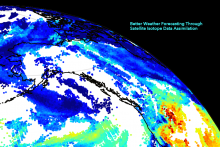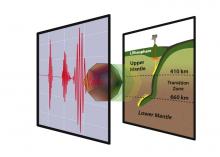Earth Sciences
News

22 Dec 2021
Scientists predict that continued global warming under current trends could lead to an elevation of the sea level by as much as five meters by the year 3000 CE.
04 Nov 2021
The diversity of threatened fish in estuaries increases when surrounded by forest cover, whereas estuaries surrounded by farmland show the opposite effect.
19 Oct 2021
An ambitious project using cutting edge environmental DNA, known as eDNA, to understand the richness of biodiversity of UNESCO’s marine World Heritage sites launches today.
14 Oct 2021
Climate change may lead to a modest net reduction in global annual energy expenditures by the end of the 21st century, according to a study published in Nature.
13 Oct 2021
The El Niño Southern Oscillation (ENSO) could impact child nutrition in many countries in the tropics, a new study in Nature Communications suggests.
20 Sep 2021
Võ Quý (31 December 1929 – 10 January 2017) was a Vietnamese ornithologist who studied the destruction of tropical forests and agricultural lands in Vietnam by Agent Orange, a herbicide used by the U.S. military during the Vietnam War.
17 Sep 2021
The Kisakata Earthquake devastated Akita and Yamagata Prefectures. More details about this Edo period disaster have been revealed thanks to a collaborative project between researchers and locals.
15 Sep 2021
Anna Mani (23 August 1918 – 16 August 2001) was an Indian meteorologist who contributed significantly to the understanding of solar radiation, ozone and wind energy by developing a wide range of measurement tools. One of India’s pioneering female scientists, Mani excelled in the male-dominated area of meteorology and became the Deputy Director-General of the India Meteorological Department.
14 Sep 2021
Researchers from The University of Tokyo assimilated satellite observations of water vapor isotopes into a weather forecasting model and found that forecast accuracy was improved by several percentage points
10 Sep 2021
A recent study conducted by the Science Unit of Lingnan University in Hong Kong (LU) shows that concentrations of fine particulate matter (PM2.5) from incense burning both inside and outside temples could be 6 times and 4 times of the recommended levels respectively. In addition, the more temples there are in the same district, the higher the respiratory mortality rate. The research team suggests that alternative measures, such as installation of automatic mist sprayers to reduce smoke dispersion, as well as using incense made with non-toxic substances to minimise health risks to worshippers and neighbours, should be considered.
27 Aug 2021
Around 650 million years ago, the Earth entered into the Marinoan glaciation that saw the entire planet freeze. The “Snowball Earth” impeded the evolution of life. But as it warmed, biotic life began to flourish. A research team from Tohoku University has analyzed rock samples from China to tell us more about this transition.
27 Aug 2021
Speakers announced for the 10th edition of IPI’s premier technology matching event
23 Aug 2021
Researchers at Ehime University have reported the sound velocity of MgSiO3 Majorite garnet up to the pressure of 18 Gigapascals and temperature up to 2,000 Kelvins. Their results lead to understanding of the mineral composition of the Earth’s mantle transition zone (MTZ), which has not been fully elucidated yet. This study suggests that a mechanical mixture of slab and mantle rocks, rather than equilibrated rocks, is more likely to explain seismological observations throughout the MTZ.
18 Aug 2021
A collaboration between Osaka City University and Setsunan University sheds light on the effect urbanization has on the flesh fly species Sarcophaga similis. Through a series of laboratory and in-field experiments, scientists show that an increase in nighttime illumination and temperature, two of the major characteristics of urbanization, can postpone S. similis hibernation anywhere from 3 weeks to a month.
27 Jul 2021
An international team of scientists say that tigers could come roaring back in an unlikely place: northeastern China.
18 Jul 2021
Using a CeO2 catalyst, researchers develop an effective catalytic process for the direct synthesis of polycarbonate diols without the need for dehydrating agents. The high yield, high selective process has CO2 blown at atmospheric pressure to evaporate excess water by-product allowing for a catalytic process that can be used with any substrate with a boiling point higher than water.
12 Jul 2021
Scientists in Singapore are calling for revisions in planned hydropower expansions in light of the rapidly decreasing cost of solar photovoltaic systems
09 Jul 2021
A new study monitored satellite images to obtain sea discoloration data as a novel indicator in detecting if an underwater volcano’s eruption is imminent.
01 Jul 2021
Scientists show that an ocean-bottom seismometer deployed close to the calving front of a glacier in Greenland can detect continuous seismic radiation from a glacier sliding, reminiscent of a slow earthquake.
18 Jun 2021
Japan recorded a whopping 3459 #landslides in 2018. To reduce the risks of landslides, researchers have developed a new #mapping system that accurately predicts their damage.
18 Jun 2021
Researchers from The University of Tokyo Institute of Industrial Science develop a flood forecasting system that could help protect people and property during typhoons
04 Jun 2021
Coral insights into 1,000 years of seasonal changes in the Arabian Sea warn of significant impacts caused by global warming.
02 Jun 2021
Scientists have uncovered a summertime climate pattern in and around the Arctic that could drive co-occurrences of European heatwaves and large-scale wildfires with air pollution over Siberia and subpolar North America.
01 Jun 2021
Carbon degassed from planetary mantles by volcanic activity plays an important role in the planetary surface environment. However, how the carbon content in the Earth’s mantle was established is still poorly understood. Here we show that the mantle of planetary embryos may have been nearly saturated with carbon by new high-pressure experiments and pointed out that the carbon solubility of magma is very consistent with the estimated carbon contents in terrestrial and lunar mantles.
17 May 2021
Landslide tsunamis are difficult to simulate because of the complex interaction between soil and water. But now, researchers from Tohoku University have come up with a hybrid numerical method that allows for relatively accurate simulations.
14 May 2021
Images from the Akatsuki spacecraft unveil why Venus’s atmosphere rotates much faster than its surface.
11 May 2021
Tomohiro Mochizuki tracks down viruses inside single-cell organisms thriving in boiling hot springs. His fieldwork is conducted in relatively extreme environments and, despite the significance of his investigations, he doesn’t need many fancy gadgets back at his lab at Japan’s Earth-Life Science Institute (ELSI). ARN asked Mochizuki about his virus-hunting exploits and what they involve.
11 May 2021
“By looking at substances in volcanos, lakes and hotsprings, you can start to see the ecosystems that existed billions of years ago,” says Mayuko Nakagawa, a microbiologist and specially-appointed assistant professor at the Earth-Life Science Institute (ELSI) based at the Tokyo Institute of Technology, Japan. She analyses components left by microorganisms with colleagues from various disciplines, while as a lab manager, she looks after cutting-edge equipment and visitors from different countries.
11 May 2021
Earth scientist Hitoshi Gomi investigates how plants are made by studying materials from the deep Earth, while creating a hospitable workplace at the Earth-Life Science Institute (ELSI) at the Tokyo Institute of Technology, Japan. He shared his research and the role of a lab manager with Asia Research News.
11 May 2021
地球の中心部の物質を研究しながら、共に研究をしている仲間が働きやすい環境を作るのが五味斎特任助教の日常だ。所属先の東京工業大学・地球生命研究所(ELSI)で地球科学者として行う研究活動と、ラボマネージャーの役目について、お話しを伺った。
Events
Sorry, nothing coming up for this discipline
Researchers
Sorry, nothing coming up for this discipline
Giants in history
Sorry, nothing coming up for this discipline


























